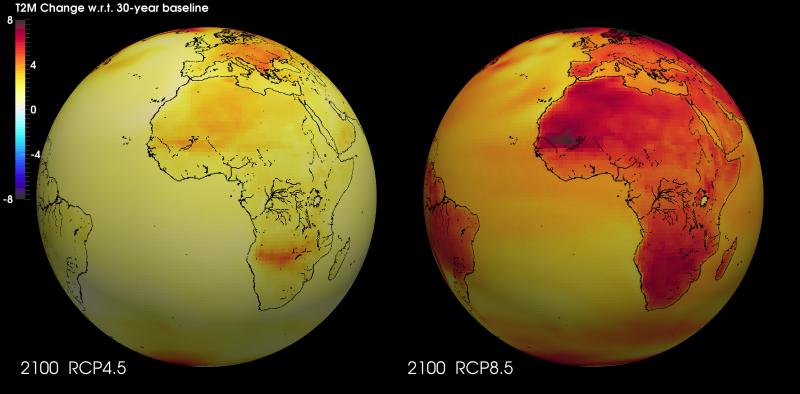Playing the climate DECK: Ireland’s involvement with CMIP6

For a newcomer it can be a challenge negotiating the thicket of acronyms that surround international initiatives on climate policy and climate research. IPCC (Intergovernmental Panel on Climate Change) is relatively well known but what about CMIP, or CMIP6 its latest phase? While the IPCC is regarded as the authoritative voice on climate change issues it does not engage directly in climate research; its role is to assess the science based on the work of climate scientists. CMIP (Coupled Model Intercomparison Project), an international group coordinating the running of simulations of the global climate system, has played a key role in supporting IPCC in its previous Assessment Reports (e.g. AR5) and is now fully engaged in its sixth phase (CMIP6) to support the IPCC with the next Assessment Report (AR6) due to be released in 2021.
The fundamental objective of CMIP is to improve our understanding of past, present and future climate change arising from natural variability or in response to changes in radiative forcing principally linked with greenhouse gas emissions. Why the intercomparison? Unfortunately, there isn’t a definitive climate model that faithfully simulates all aspects of the climate; all models have strengths and weaknesses and by comparing the outputs of controlled simulations from different models further insights can be gained on climate linkages and model errors. While some models may only handle the atmosphere the emphasis is on coupled systems i.e. capable of simulating the atmosphere and ocean/sea-ice and the exchange of CO2 between the two, or a full Earth System Model (ESM) that also includes the biosphere.
The coordination feature of CMIP6 is very important as it enables the scientific community to focus more effectively on knowledge gaps in the understanding of the Earth’s climate system, the themes of which are summarised under the Grand Sciences Challenges of the World Climate Research Programme (WCRP). In particular, CMIP6 will attempt to address the questions:
- How does the Earth system respond to forcing (e.g. from greenhouse gas emissions)?
- What are the origins and consequences of systematic Climate model biases?
- How can we assess future climate changes given internal climate variability, predictability, and uncertainties in emission scenarios?
More particularly, CMIP6 lays out a framework of climate simulations that supporting groups may choose to pursue. It includes the DECK (Diagnostic, Evaluation and Characterization of Klima; an awkward acronym using the Greek word, klima, for climate) and historical simulations (1850 – near-present), the latter to document the basic features of model performance across different phases of CMIP.
An agreed ensemble of Model Intercomparison Projects (MIPs), 21 in total, provides further refinement to address specific science topics. One that is likely to generate a lot of interest is ScenarioMIP, which will provide multi-model climate projections based on alternative scenarios of future emissions and land use changes for at least the 21st century. Others include the Coordinated Regional Downscaling Experiment (CORDEX) diagnostic MIP which focuses on regional climate and the Decadal Climate Prediction Project (DCPP) MIP which will investigate our ability to skilfully predict climate variations from a year to a decade ahead.
Crucially, CMIP6 requires that data outputs comply with common standards and are made publicly available, with supporting documentation, for analysis by the science community through the Earth System Grid Federation (ESGF).
Clearly, participation in CMIP6 is a major undertaking and only large modelling groups have the necessary resources (including access to substantial computing power and storage) to engage in the project. Irish participation comes through the EC-Earth climate modelling consortium. As a member of EC-Earth, the Irish Centre for High-End Computing (ICHEC) has committed to running advanced climate simulations using the EC-Earth Earth System Model.
In particular, researchers at ICHEC, through an EPA-funded project (and in collaboration with Met Éireann), are currently working on developing the EC-Earth model in preparation for running a large ensemble of CMIP6 EC-Earth simulations on the ICHEC and European supercomputing systems. The EC-Earth CMIP6 simulations will provide sharper and more accurate projections of the future global climate and lead to a better understanding, not only of the physical climate system, but also of the climate impact on societies. The resulting analysis of the climate projections will enhance the overall understanding of anthropogenic climate change on a global scale and will assist in presenting a case for a follow-on to the COP21 agreements. The simulations will be included for assessment in the expected IPCC AR6 reports.
ICHEC are committed to running the following EC-Earth CMIP6 contributions:
- 12 simulations with standard spatial resolution (~80km) for the period, 1850-2100. The future climate will be simulated for all four RCP scenarios (2.6, 4.5, 6.0, & 8.5),.
- 2 high-resolution (~40km) 1951-2100 simulations
The planned simulations, outlined above, are a minimum estimation of our planned CMIP6 contributions. The current ICHEC system, fionn, will be replaced in early 2018 with a substantially more powerful machine. This will allow for the EC-Earth ensemble size to be increased and for the models to be run at a finer spatial resolution.
As part of a separate EPA-funded project at ICHEC, the CMIP6 EC-Earth data will be dynamically downscaled to provide sharper regional projections for Europe (EURO-CORDEX project) and Ireland.
The data will be stored on the ESGF node at ICHEC, where it will be published and made available to national researchers and the wider international research community such as CORDEX and CMIP6.
CMIP5 EC-EARTH climate projection data. The annual 2m temperature change with respect to the 30-year baseline (1961-1990) is presented for both the RCP4.5 (medium) and RCP8.5 (high) scenarios.
For further details on CMIP6 see https://www.wcrp-climate.org/wgcm-cmip/wgcm-cmip6




